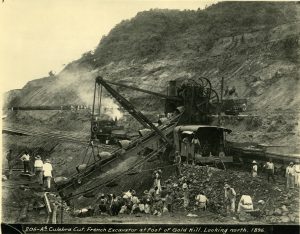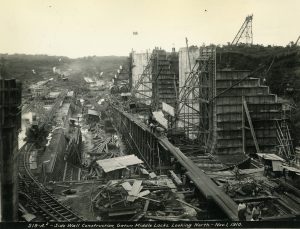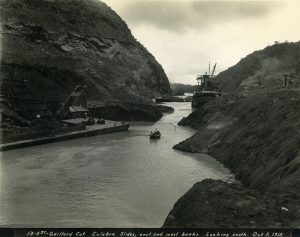The Panama Canal is considered one of the Seven Wonders of the Modern World. In June 2016, an extensive nine year expansion to accommodate larger and deeper shipping vessels was completed. The Panama Canal is just as significant to industry and consumer savings today as it was when it first opened in 1914.
 French Excavator at Culebra Cut, 1896. Schuyler Otis Bland Papers, 1962-1950, Mss. 65 B61.
French Excavator at Culebra Cut, 1896. Schuyler Otis Bland Papers, 1962-1950, Mss. 65 B61.Stretching fifty miles across the isthmus of its namesake country, the Canal offered a shortcut that would dramatically alter shipping upon opening in 1914. The shortcut through Panama saved a significant amount of time and money for industry and consumers. Construction was started in the 1880s by the French under the direction of Count Ferdinand de Lesseps, who had previously worked with Egypt on the Suez Canal; it was completed over thirty years later by the United States at significant cost. The estimated cost for the United States was $350 million, and roughly 5,600 workers lost their lives during construction. Over 3.4 million cubic meters of concrete were used to build the locks, 240 million cubic yards of rock and dirt were excavated along the canal path, (panamacanalfacts.com).
 Sidewall Construction, Gatun Middle Locks, 1910. Schuyler Otis Bland Papers, 1962-1950, Mss. 65 B61.
Sidewall Construction, Gatun Middle Locks, 1910. Schuyler Otis Bland Papers, 1962-1950, Mss. 65 B61.
As a major proponent of the shipping industry and the United States Merchant Marines, Congressman Schuyler Otis Bland worked closely with the Panama Canal Zone and the officials who oversaw the Canal Zone Territory. Photographs included here were collected by Congressman Bland during his visit to the Panama Canal in the 1930s.
 Gaillard Cut, Culebra Slides, 1915. Schuyler Otis Bland Papers, 1962-1950, Mss. 65 B61.
Gaillard Cut, Culebra Slides, 1915. Schuyler Otis Bland Papers, 1962-1950, Mss. 65 B61.
Sources referenced:
A & E Networks, "Panama Canal," History.com Staff, 2015. accessed June 23, 2016, http://www.history.com/topics/panama-canal.
"Panama Canal History," last modified March 1, 2016, accessed June 23, 2016, http://panamacanalfacts.com/history/.